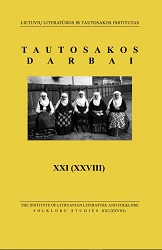American Proverbs as an International, National, and Global Phenomenon
American Proverbs as an International, National, and Global Phenomenon
Author(s): Wolfgang MiederSubject(s): Cultural history, Theoretical Linguistics, Comparative Linguistics, Translation Studies, Phraseology
Published by: Lietuvių literatūros ir tautosakos institutas
Keywords: American proverbs; paremiography; global phenomenon;
Summary/Abstract: Proverbs as one of the smallest ubiquitous folklore genres have been collected and studied since the beginning of written records. Both paremiographers and paremiologists have been hard at work at publishing collections and treatises throughout the world. In fact, proverb scholarship has reached such a phenomenal level of accomplishment that it is difficult for the fledgling proverb scholar to deal with the plethora of valuable information (see Moll 1958; Mieder 1982, 1990, 1993, 2001). And yet, as is true for most intellectual endeavors, there still remains much work to be done in both areas of proverb studies. The varied use and function of proverbs as cultural signs and strategically placed rhetorical devices need to be investigated in much more detail by paying attention to different historical periods (Burke 1941; Seitel 1969; Obelkevich 1987; Profantová 1998). Much can also still be learned by socio and psycholinguistic approaches that look at proverbs from the point of view of cognition, comprehension, and communication (Mieder 2003a). Above all, much more attention should be paid to the continued employment of proverbs in the modern age of technology, the mass media, the internet, and general globalization (Mieder 1993). But additional proverb collections based on serious lexicographical principles are also a definite desideratum, including regional, national, and international compilations. While much is known about common European proverbs, it is high time to assemble comprehensive and comparative African as well as Near and Far Eastern proverb collections. Such compendia will eventually enable paremiographers to isolate fundamental proverb types that connect peoples through common wisdom all over the world (Mieder 1990; Grigas 1996, 2000a).
Journal: Tautosakos darbai
- Issue Year: 2005
- Issue No: 30
- Page Range: 57-72
- Page Count: 16
- Language: English

